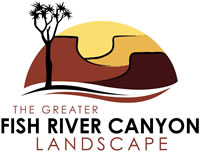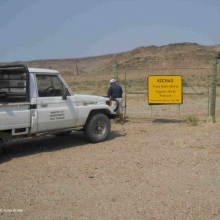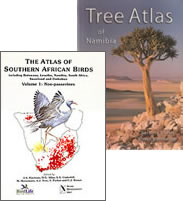Conservation Areas
National Monument
Fish River Canyon
The Fish River Canyon was declared a National Monument on the 1st of August 1962 by the Historical Monuments Commission for South West Africa.
State Protected Areas
/Ai-/Ais Hotsprings Game Park
The /Ai-/Ais Hotsprings Game Park is the Namibian Section of the /Ai-/Ais/Richtersveld Transfrontier Park. The transfrontier park is managed by a Joint Management Board with conservation officials from both, South African National Parks (SANParks) and the Namibian Ministry of Environment and Tourism. The /Ai-/Ais Hotsprings Game Park was proclaimed in several steps from 1968 to 2002 and covers today 4348 km2.
Naute Recreational Resort
The Naute Game Park surrounds Namibia’s second largest dam, the Naute. The dam was constructed from 1970 to 1972 to capture the Löwen River with its tributaries, which later feeds into the Fish River. The resort is situated about 42 km south-west of Keetmanshoop and supplies the town with water. A successful irrigation projec t was initiated below the dam wall in 1991 and date palms and grapes are currently cultivated here. A small game reserve surrounds the dam.
| Park size: | 225 km² |
| Proclaimed: | 1988 |
| Natural features: | Dominated by grassy plains with small shrub species. Trees grow in river washes. The dam has several sandy shores, shallow bays and islands. |
| Vegetation: | Nama Karoo Biome. Vegetation types: Dwarf Shrub Savannah, Karas Dwarf Shrubland. Camel-thorn (Acacia erioloba), sweet-thorn(Acacia karroo), water acacia (Acacia nebrownii), wild tamarisk (Tamarix usneoides), trumpet-thorn (Catophractes alexandri) and quiver tree(Aloe dichotoma). |
| Wildlife: | Gemsbok, springbok, klipspringer, steenbok, duiker. The 164 bird species recorded include African spoonbill, South African shellduck, African fish eagle, African white pelican. |
| Tourism: | Camping, angling and boating permits are obtained from the MET. Campsites with basic ablution facilities and a kiosk (under NamWater concession). With the exception of a small area along the southern bank of the dam, the game park is closed to the public. |
Key management issues: Littering, chopping of trees and disturbance to game and birds by humans is a problem. MET staff do not have jurisdiction in all areas of the park. People enter illegally to reach angling areas. Poaching has been a problem in the past due to secondary roads bordering the park. Snares and traps are sometimes found, but good law enforcement has controlled poaching. The staff infrastructure is limited. There is no permanent electricity supply and water is transported 15 km by vehicle.
Future plans: Possible management with the neighbouring Gawachab Conservancy is envisaged, as well as the development of a 600 hectare area on the southern bank for tourism purposes.
Private Reserves
Gondwana Canyon Park
With an area of 1,260 km² and the first piece of land acquired in 1995, the Gondwana Canyon Park is the largest and oldest nature reserve of the Gondwana Collection. Before its purchase by Gondwana Collection, it comprised nine separate multiple-purpose farms – mainly small-stock, some small-scale tourism, and some wildlife utilisation (trophy hunting, biltong hunting, own use). Since its inception the focus has been to manage the land for biodiversity and landscape conservation and to use the land primarily for low impact tourism.
Canyon Nature Park
This is situated on the west side of the canyon.
Transboundary Reserves
Richtersveld National Park
The Richtersveld National Park in South Africa forms an important transboundary link with the /Ai-/Ais Hotsprings Game Park.
Relevant literature
-
/Ai-/Ais-Richtersveld Transfrontier Park - A short guide to the long history
/Ai-/Ais-Richtersveld Transfrontier Park - A short guide to the long history. Ministry of Environment and Tourism
Contradictions in the literature abound, so would you please settle the question – after the Grand Canyon in the USA, is the Fish River Canyon the second-largest canyon in the world? The answer is that it depends on how you define large. At about 1 000 metres deep, Ethiopia's Blue Nile Gorge is considered to be Africa's largest canyon, but it is also narrower (about 20 km wide at its widest) than the Fish River Canyon, and probably shorter too. (The Fish River Canyon is 160 km long, up to 27 km wide, and almost 550 metres at its deepest.) So which is Africa’s largest canyon? Toss a coin, or visit both gorges, then you may be able to answer the question for yourself.» Download -
/Ai-/Ais-Richtersveld Transfrontier Park - Discover the /Ai-/Ais Richtersveld Transfrontier Park
/Ai-/Ais-Richtersveld Transfrontier Park - Discover the /Ai-/Ais Richtersveld Transfrontier Park
Experience wilderness on a scale unimaginable. Stand at the edge of the largest natural gorge in Africa, and the second-largest canyon in the world, the Fish River Canyon. Revel in the dramatic views from Hell’s Corner where it is almost possible to imagine the dramatic natural forces that shaped the canyon. Today the /Ai-/Ais Richtersveld Transfrontier Park protects a vast area that crosses the South African border to encompass one of the richest botanical hot spots in the world, the Succulent Karoo biome.» Download -
/Ai-/Ais-Richtersveld Transfrontier Park - Hiking the Fish River Canyon
/Ai-/Ais-Richtersveld Transfrontier Park - Hiking the Fish River Canyon. Ministry of Environment and Tourism
The Fish River Canyon hiking trail is one of the most challenging hikes in Southern Africa. It is 90 km long, or around 80 km if you take advantage of the shortcuts. It takes four to five days to complete, and once you are down on the floor of the canyon, it is difficult to climb out, so be fully prepared. Please note – there are only two emergency exits along the trail.» Download -
Burke A. (2020) Endemic plants of the Sperrgebiet. EnviroScience & Namibian Chamber of Environment, Windhoek.
Burke A. (2020) Endemic plants of the Sperrgebiet. EnviroScience & Namibian Chamber of Environment, Windhoek.
This photographic guide book introduces plants endemic to Namibia and is written for non-specialists.» Download -
Endemic plants of the Sperrgebiet. Poster 1 by EnviroScience
Endemic plants of the Sperrgebiet. Poster 1 by EnviroScience
» Download -
Endemic plants of the Sperrgebiet. Poster 2 by EnviroScience
Endemic plants of the Sperrgebiet. Poster 2 by EnviroScience
» Download -
Endemic plants of the Sperrgebiet. Poster 3 by EnviroScience
Endemic plants of the Sperrgebiet. Poster 3 by EnviroScience
» Download -
Endemic plants of the Sperrgebiet. Poster 4 by EnviroScience
Endemic plants of the Sperrgebiet. Poster 4 by EnviroScience
» Download -
Management & Development Plan for the Gondwana Cañon Park
Management & Development Plan for the Gondwana Cañon Park for the period of 2008-2013This Management and Development Plan (MDP) sets out the vision, objectives and guidelines for the management and development of the Gondwana Cañon Park (GCP).» Download -
Managing biodiversity in the /Ai-/Ais Hotsprings Game Park
Burke, A. 2011. Managing biodiversity in the /Ai-/Ais Hotsprings Game Park. A tool for conservation-, resource- and development planners. EnviroScience & SPAN
The /Ai-/Ais Hotsprings Game Park is the Namibian Section of the /Ai-/Ais/Richtersveld Transfrontier Park (ARTP) in the south of Namibia. Although a joint management plan exists for the Transfrontier Park, detailed information on biodiversity in the Namibian section of the park was lacking. This document addresses this gaps and describes landscape units and their biodiversity importance, highlights knowledge gaps reviews current land uses and proposed zoning and provides guidelines for managing these landscape units.» Download -
Mountain Zebra Project – 4th progress report
Gosling, M. 2012. Mountain Zebra Project – 4th progress report. Population ecology of Hartmann’s mountain zebra: comparisons between protected areas in southern Namibia.
This is the fourth progress report on a long-term study of the population ecology, social evolution and conservation of Hartmann’s mountain zebra. The aim of the study is to provide information to help support the conservation of this sub-species in Namibia.» Download -
Naute Recreation Resort - Profile
Naute Recreation Resort - Profile. Ministry of Environment and Tourism
The Naute Game Park surrounds Namibia's second largest dam, the Naute. The dam was constructed from 1970 to 1972 to capture the Löwen River with its tributaries, which later feeds into the Fish River. The resort is situated about 42 km south-west of Keetmanshoop and supplies the town with water. A successful irrigation project was initiated below the dam wall in 1991 and date palms and grapes are currently cultivated here. A small game reserve surrounds the dam.» Download -
Plant species of the Naute Game Park
Burke, A. 2014. Plant species of the Naute Game Park – an annotated inventory. Dinteria 34: 3-11
This paper presents an inventory of plants of the Naute Game Park, based on field surveys and information from databases. The park extends over two quarter degree squares and 159 terrestrial plant species have to date been recorded. Deciduous dwarf shrubs comprise the majority of the flora. The rare, small tree Elephantorrhiza rangei and populations of quiver tree (Aloe dichotoma), Nama corkwood (Commiphora namaensis), Nama resin-tree (Ozoroa namaensis) and black-winged twin-leaf (Zygophyllum cretaceum) are of conservation importance on the inselbergs. Also of conservation importance are the Namibian endemics Euphorbia lignosa, Geigeria brachycephala, Indigofera pechuelii, Phyllanthus dinteri, Salsola arborea and kinkelbos (Tetragonia schenkii) as well as unidentified dwarf stem-succulent Apocynaceae (Stapeliod) and Hoodia species. Invasive alien mesquite (Prosopis) trees may locally pose a threat to indigenous plants. More stringent track control in the recreational part of the park would limit the disturbance of natural habitat.» Download -
The ecological, social & economic implications of private game parks & private nature reserves in Namibia
The ecological, social & economic implications of private game parks & private nature reserves in Namibia
The Ministry of Environment & Tourism commissioned this study into the ecological, social, and economic implications of private game parks and nature reserves in Namibia. The Ministry engaged the services of an independent team of researchers consisting of an ecologist, an economist and a lawyer.» Download





